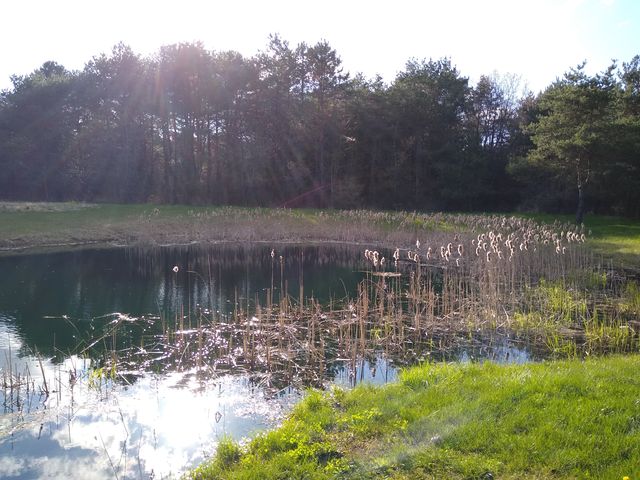Common Cattail Plant, shoreline reed
Cattails, scientifically known as Typha latifolia, are common weeds found in ponds, lakes, and wetland areas. Common names include broadleaf cattail, common cattail, and cat o nine tails.
They have tall stalks of green blades that can grow 6-10 feet tall. At the top of the stalks, cattails produce brown fuzzy catkin flower spikes. These catkins resemble a cigar in shape and color. They spread easily through rhizomes and seeds. One cattail seed head can produce 250,000 seeds each year, which can be carried to other areas by wind or birds.
Burreed is a shoreline reed that looks similar to the cattail. Burreed is a shorter green blade or reed but has no "catkin". Pragmites is another tall reed that grows in wet areas and along pond or lake shores. The phramites produce a tassle at the top similar to the top of a corn stalk.


Spreading Cat tails
Cattails spread easily. They can grow in moist soil conditions and in water up to 4 feet deep. Cattails spread by rhizome (root extensions) and seed.
One cattail seed head can produce 250,000 seeds each year. They can be introduced to a new pond through wind dispersal of seeds, carried by birds, or even unintentionally introduced by humans or animals. Cattail seeds can remain viable for years.
Once cattail seeds reach a new pond, they can quickly establish themselves and start growing, especially in moist soil conditions and shallow water. It is easy for the population to spread rapidly in clear shallow water less than 30" deep. Root mats can float and extend out into deeper water.
It's important to manage cattails to prevent them from becoming invasive and overrunning a pond or wetland area.
Are cattails good for a pond?
Cattails can be beneficial to a pond's health in several ways. They provide nesting habitat for fish and protection for small fish. Frogs and salamanders lay eggs in and around stalks. Waterfowl use these stands of vegetation as nesting spots.
Typha latifolia create a buffer for new water entering the pond. Cattails filter unwanted nutrients like nitrate and phosphate, metals, and sediment, which helps improve water quality.
However, it's important to note that cattails can attract undesired wildlife like muskrats and geese, and mosquitoes are also attracted to the stagnant water where cattails grow. They also produce a significant amount of organic mass from their growth. This mass adds more nutrients to water and reduces the depth of the pond or lake.
If left unmanaged, cattails can become invasive and overtake a pond, limiting access and reducing water depth. Spot treating cattails with herbicides or manually removing them are common methods of control to ensure that they don't take over a pond.
Red Wing Blackbird Babies Nest In Cattails
Are cattails invasive?
Cattail weed can be considered invasive if left unmanaged. They have the potential to overtake a pond, limit access, and reduce water depth. It's essential to control their population to prevent them from becoming invasive and dominating the pond or wetland area.
How to get rid of cattails in a pond
Removing vegetation with a rake or pulling by hand are possibilities. They are both time consuming but safe options. Removing with equipment is faster but can have negative results. Accidentally digging too deep to remove roots can create pond leaks.
Any fragment of the cattail root that is left behind can also sprout a new plant. For larger stands of cattails, this is why aquatic safe herbicides are often the most effective choice.
How to kill cattails
The Cattail Killer Pack is the best treatment option to kill cattails to the roots. This kit includes Clearcast, Cattzilla, and MSO. By mixing these treatments together and tank spraying on vegetation, there is better contact & penetration. The Cattzilla speeds up break down time of stalks. There are no water use restrictions after use. Results in 7-10 days.
Clearcast is an effective aquatic herbicide for cattails. It is important to wait to spray until stalks are at least 12" tall. Tank spray vegetation directly. There are no water use restrictions after use. Results begin to be noticed after 1-2 weeks. After cattail herbicide kills weeds, follow up with Muck Remover pellets to break down dead waste and muck. Muck Remover cleans shorelines and restores them to their former beauty.
When is the best time to spray cattails?
It is important to wait until the vegetation is at least 12 inches tall before applying herbicides. This ensures that the herbicide has the best chance of being absorbed by the plant and effectively killing it.
Treating cat tails during this time helps prevent them from spreading and taking over the pond or wetland area. Follow-up treatments are often needed to kill larger groups of cattails.
Can I treat a portion of the cattails?
Yes, it is possible to treat a specific portion of the cattails using a topical application method. By applying the treatment directly to the targeted area, only the cattails that come into contact with the sprayed solution will be affected. This allows you the flexibility to control a certain percentage or a specific section of the cattails, depending on your desired outcome. Using this approach, you can effectively manage the growth or mitigate the spread of cattails without affecting the surrounding vegetation or areas where treatment is not required.
Cattail Control Options
Need help identifying your POND WEED or How Much Treatment To Use?
Click Here To Submit Your Pond Help Request
